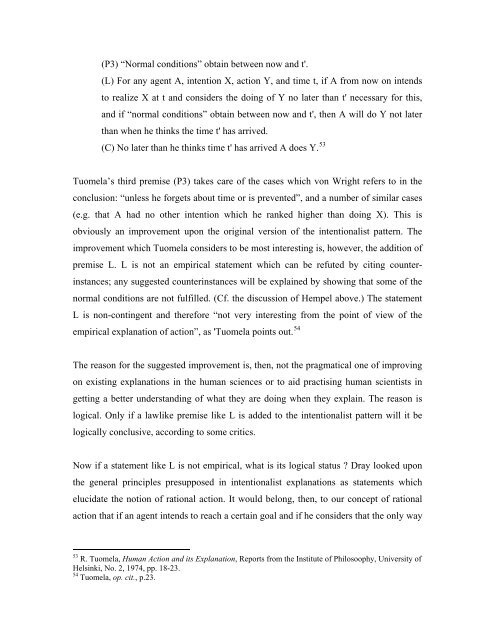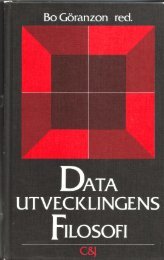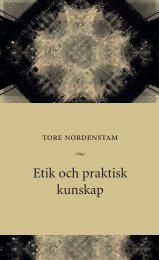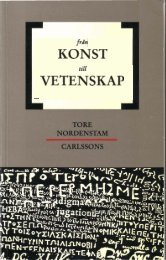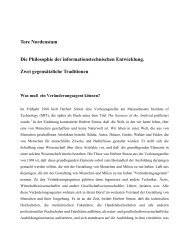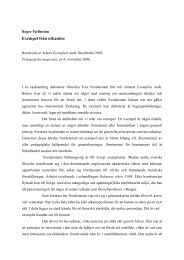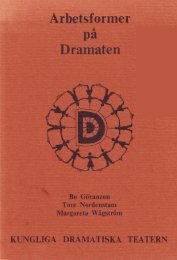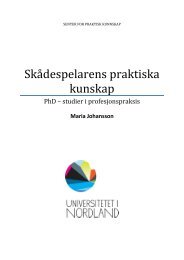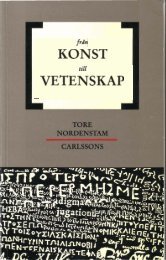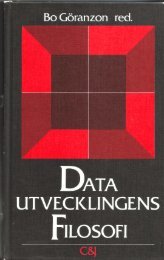tore nordenstam explanation and understanding in the history of art
tore nordenstam explanation and understanding in the history of art
tore nordenstam explanation and understanding in the history of art
Create successful ePaper yourself
Turn your PDF publications into a flip-book with our unique Google optimized e-Paper software.
(P3) “Normal conditions” obta<strong>in</strong> between now <strong>and</strong> t'.<br />
(L) For any agent A, <strong>in</strong>tention X, action Y, <strong>and</strong> time t, if A from now on <strong>in</strong>tends<br />
to realize X at t <strong>and</strong> considers <strong>the</strong> do<strong>in</strong>g <strong>of</strong> Y no later than t' necessary for this,<br />
<strong>and</strong> if “normal conditions” obta<strong>in</strong> between now <strong>and</strong> t', <strong>the</strong>n A will do Y not later<br />
than when he th<strong>in</strong>ks <strong>the</strong> time t' has arrived.<br />
(C) No later than he th<strong>in</strong>ks time t' has arrived A does Y. 53<br />
Tuomela’s third premise (P3) takes care <strong>of</strong> <strong>the</strong> cases which von Wright refers to <strong>in</strong> <strong>the</strong><br />
conclusion: “unless he forgets about time or is prevented”, <strong>and</strong> a number <strong>of</strong> similar cases<br />
(e.g. that A had no o<strong>the</strong>r <strong>in</strong>tention which he ranked higher than do<strong>in</strong>g X). This is<br />
obviously an improvement upon <strong>the</strong> orig<strong>in</strong>al version <strong>of</strong> <strong>the</strong> <strong>in</strong>tentionalist pattern. The<br />
improvement which Tuomela considers to be most <strong>in</strong>terest<strong>in</strong>g is, however, <strong>the</strong> addition <strong>of</strong><br />
premise L. L is not an empirical statement which can be refuted by cit<strong>in</strong>g counter<strong>in</strong>stances;<br />
any suggested counter<strong>in</strong>stances will be expla<strong>in</strong>ed by show<strong>in</strong>g that some <strong>of</strong> <strong>the</strong><br />
normal conditions are not fulfilled. (Cf. <strong>the</strong> discussion <strong>of</strong> Hempel above.) The statement<br />
L is non-cont<strong>in</strong>gent <strong>and</strong> <strong>the</strong>refore “not very <strong>in</strong>terest<strong>in</strong>g from <strong>the</strong> po<strong>in</strong>t <strong>of</strong> view <strong>of</strong> <strong>the</strong><br />
empirical <strong>explanation</strong> <strong>of</strong> action”, as 'Tuomela po<strong>in</strong>ts out. 54<br />
The reason for <strong>the</strong> suggested improvement is, <strong>the</strong>n, not <strong>the</strong> pragmatical one <strong>of</strong> improv<strong>in</strong>g<br />
on exist<strong>in</strong>g <strong>explanation</strong>s <strong>in</strong> <strong>the</strong> human sciences or to aid practis<strong>in</strong>g human scientists <strong>in</strong><br />
gett<strong>in</strong>g a better underst<strong>and</strong><strong>in</strong>g <strong>of</strong> what <strong>the</strong>y are do<strong>in</strong>g when <strong>the</strong>y expla<strong>in</strong>. The reason is<br />
logical. Only if a lawlike premise like L is added to <strong>the</strong> <strong>in</strong>tentionalist pattern will it be<br />
logically conclusive, accord<strong>in</strong>g to some critics.<br />
Now if a statement like L is not empirical, what is its logical status ? Dray looked upon<br />
<strong>the</strong> general pr<strong>in</strong>ciples presupposed <strong>in</strong> <strong>in</strong>tentionalist <strong>explanation</strong>s as statements which<br />
elucidate <strong>the</strong> notion <strong>of</strong> rational action. It would belong, <strong>the</strong>n, to our concept <strong>of</strong> rational<br />
action that if an agent <strong>in</strong>tends to reach a certa<strong>in</strong> goal <strong>and</strong> if he considers that <strong>the</strong> only way<br />
53<br />
R. Tuomela, Human Action <strong>and</strong> its Explanation, Reports from <strong>the</strong> Institute <strong>of</strong> Philosoophy, University <strong>of</strong><br />
Hels<strong>in</strong>ki, No. 2, 1974, pp. 18-23.<br />
54<br />
Tuomela, op. cit., p.23.


